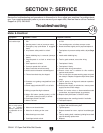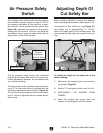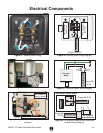
G0644 15" Open-End Wide Belt Sander
-35-
5. Place the sanded workpiece under the sand-
ing drum and lower the sanding cabinet
until the sanding drum is just touching the
workpiece.
6. Remove the workpiece from under the sand-
ing drum and position it directly under the
depth of cut safety bar.
7. Loosen the three hex bolts securing the
safety bar.
8. Use feeler gauges to raise the safety bar
approximately
3
⁄64" (0.047") above the
workpiece from side-to-side.
9. Re-tighten the hex bolts.
10. Re-install the sanding belt and secure the
access door.
Adjusting Pressure
Rollers
The height of the pressure rollers (see Figure
38
) is set below the sanding drum to keep the
workpiece firmly against the conveyor belt as it
passes through the sander, preventing workpiece
kickback.
The pressure roller height was factory set at
approximately
1
⁄16" (0.063") below the lowest point
of the sanding drum.
To adjust the height of the pressure rollers:
1. Make sure the sanding drum and conveyor
are parallel (
Page 32).
2. Sand a 15" wide piece of stock until it is flat.
3. DISCONNECT THE SANDER FROM
POWER!
4. Open the sanding belt access door and
remove the sanding belt from the sander.
5. Loosen the eight cap screws securing the
front and rear pressure rollers to the sanding
cabinet (see
Figure 39).
Figure 38. Pressure rollers.
Rear
Pressure
Roller
Front
Pressure
Roller
6. Place the workpiece under the sanding
drum.
7. Use feeler gauges to position the sanding
drum approximately
1
⁄16" (0.063") above the
sanded workpiece from Step 2
.
8. Adjust the pressure rollers so that they are
lightly resting on the workpiece from side-to-
side, then re-tighten the cap screws to secure
the pressure rollers in place.
9. Re-install the sanding belt and secure the
access door.
adjusting pressure rollers
Figure 39. Pressure roller cap screws (front
pressure roller cap screws shown)
Cap Screws
Cap Screws


















